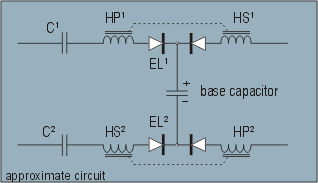

|
DIELECTRIC ABSORPTION BLOCKS versus ELECTRET BLOCKS
The reason why I believe that the Testatika’s horseshoe blocks are not ELECTRETS is that when you look at a similar configuration of blocks used in each top corner of Methernitha's Tini machine (see Tini video 995 kb (This may not work on some computers) this machine’s blocks give more of an indication that they are used as electron cascade generators to increase the amount of available electrons in the surrounding air that the generators can collect from, and I believe they are used on the Testatika in a similar way.
But, there are certain advantages to having electrets squeezed between the feet of the horseshoes as we shall see below. What, though, is an ELECTRET…
How to make an ELECTRET… There are two sets of instructions on how to make an electret that I know of but I’m sure there are more, one is the original paper by the Japanese physicist M. Eguchi N3, and the other is by C.L. Strong published in Scientific American N4. But a word of warning, in making electrets proper precautions are important; the process can be hazardous especially when the dielectric material is melted to its liquid form, for it looses its insulation resistance, and then the high tension electrizing process can become unpredictable and even explosive. The trick is to heat the plastic blocks until they are soft and then take the heat away (with ample experimentation first to observe how the plastic reacts). DIELECTRIC ABSORPTION is almost exactly the same although it is not so permanent an effect as that which the electret process produces. From the early days of electronics when research into insulators and dielectrics was almost as important as research into conductors, it was noted that dielectrics exhibited ’elastic stress’ whereupon they would absorb amounts of electricity into their structure. This ’mystery’ was subjected to many theories and much experimentation during the 1800’s but it was James C. Maxwell N5 who came up with a mathematical formulae for it and the explanation that it resulted from charge accumulations on the interfaces separating regions of different components that make up the dielectric material itself.
The HORSESHOES and why they are there… One problem in a Testatika type electric circuit is that there has to be sufficient isolation of the rotating discs’ electrostatic field transfer system otherwise the whole thing will grind to a halt in a matter of seconds. Electrostatic influence machines do have a tendency to die if their charges are wrongly transferred (or not properly neutralised etc), and provision against this is very evident in the circuit assembly and connections shown in the photographs taken of the Testatikas (see circuit diagram).
Firstly there is a conductive break in the form of capacitor C1 (and for the return section C2), which will only be crossed by an alternating (or pulsed) current; and secondly there is a conductive break by the horseshoe coil windings (see fig.4), which are mutually coupled to eachother through induction (through the iron or mumetal of the horseshoe) but are not directly connected and will, again, only pass an alternating (or pulsed) current between them. So, while these two factors provide the isolation needed, at the same time they ensure that an alternating (or pulsed) current can pass between the electrostatic generator and the oscillating, rectifying, and transforming parts of the circuit.
But here, possibly, between the feet of the horseshoes are the main
reasons for using electrets instead of plain uncharged plastic blocks.

I suppose it would also make sense, while providing 'electrodes' for these electret blocks, as in the form of metal plates, that it would be advantageous to choose two such different metals so that when they touched they would pass current more easily in one direction than in the other. When the two are linked aluminium is positive while copper is negative - but it would be even better to use a zinc / copper combination (see Horseshoe Magnets page) and moreover, zinc more readily gives off electrons from its surface.
NOTES: N2 - See "Electrostatics – And its Applications" by A.D. Moore (1973) is a very well researched book on electrets (p122 – 130) and electrostatic machines; "Handbook of Electrostatic Processes" by Jen-Shih Chang (1995) pp509 on electrets. N3 - The first person to make an electret was Mototaro Eguchi, see his "On the Permanent Electret" paper in "Philosophical Magazine" Vol 49 (1925) pp178. N4 - "How to Make an Electret" by C.L. Strong in "Scientific American" Vol 203 (Nov 1960) p202 – 210 is a practical description of how to make an electret using carnauba wax. N5 - "A Treatise on Electricity and Magnetism" by James C. Maxwell Vol 1 (1881) # 325 – 334. And see above for A.D. Moore (p122). N6 - See "Dielectrics" by P.J. Harrop (1972) p71 for dielectric absorption. Doping the dielectric with, for instance, paramagnetic particles will increase the amount of, and surface area of, the interfaces; which is one reason why their inclusion in a dielectric increases the ionising effect. But see the Patrick Flanagan Electron Field Generator page too.
|
All articles in this series copied with permission from Paul E. Potters excellent website
check out the webmasters original article on the swiss ml
Some interesting comments and ideas on the Free energy machine Swiss ML or Testatika Thestica Distakica
I have an Australain Pal format copy only of this video
email me for pricing details Australian residents only
